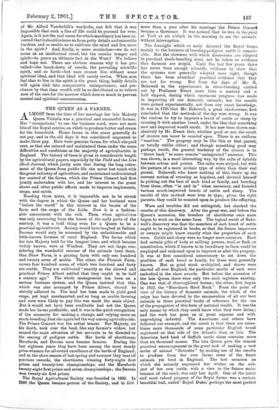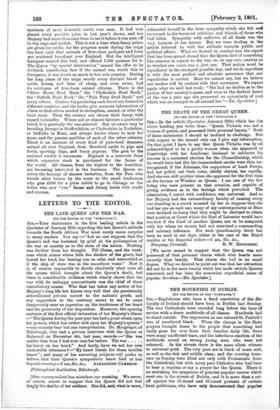THE QUEEN AS A FA_RAITIR.
ALMOST from the time of her marriage her late Majesty Queen Victoria was a practical and successful farmer. Her " occupations," to use the business word, were not mere bits of the Royal estates, on which to produce butter and cream for the household. Home farms in this sense generally do not pay, and in the old days it was considered ungenteel to make them pay. Hers were genuine farms, for which she paid rent, so that she entered and maintained them under the same difficulties and conditions as the majority of agriculturists in England. The history of these is given at considerable length by the agricultural papers, especially by the Field and the Live Stock Journal, which justly note that during the long retire- ment of the Queen from public life she never lost touch with the great industry of agriculture, and maintained undiminished her control of the farms, which the Prince Consort had first jointly undertaken with her, and her interest in the great shows and other public efforts made to improve implements, crops, and cattle.
Reading these notes, it is impossible not to be struck with the degree in which the Queen and her husband were `° before the world" in this interest in the beasts of the farm and the crops of the fields. Now it is a fashion- able amusement with the rich. Then, when agriculture was only recovering from the losses of the early parts of the century, it was a hold thing even for a Queen to be a practical agriculturist. Society would have laughed at failure. Success would only be esteemed by the unfashionable and little-known farmers of rural England. The farms which her late Majesty held for the longest time, and which became widely known, were at Windsor. They are not large, con- sidering the wonderful success of the animals bred there. One, Shaw Farm, is a grazing farm with only one hundred and twenty acres of arable. The other, the Flemish Farm, covers four hundred acres, of which two hundred and forty are arable. They are cultivated " exactly as the shrewd and practical Prince Albert settled that they ought to be half a century ago." The whole management has been on a serious business system, and the Queen insisted that this, which was also arranged by Prince Albert, should be strictly adhered to. The land has been made to yield good crops, yet kept unexhausted, and so long as arable farming and corn were likely to pay this was made the main object. But it would not have been creditable had not the Queen made her farms profitable; and it was in the quick recognition of the necessity for making a change, and relying more on stock-breeding, that she again led the way among agriculturists. The Prince Consort was the actual tenant. Her Majesty, on his death, took over the land, like any farmer's widow, but caused the main attention of her servants to be directed to the rearing of pedigree cattle. Her herds of shorthorns, Herefords, and Devons soon became famous. During the last eighteen years they have been among the most steady prize-winners for all-round excellence of the herds of England; and in the show season of last spring and summer they beat all previous records, the shorthorns winning forty-eight first prizes and twenty-two championships, and the Herefords twenty-eight first prizes and seven championships ; the Devons won twenty-six first prizes.
The Royal Agricultural Society was founded in 1839. In 1840 the Queen became patron of the Society, and in littl more than a year after his marriage the Prince Consort became a Governor. It was noticed that he was in the yard at York at six o'clock in the morning to see the animals without interruption.
The foresight which so early diverted the Royal farms mainly to the business of breeding pedigree cattle is remark- able. But the slowness with which discoveries are adopted in practical stock-breeding must not be taken as evidence that farmers are stupid. Until the last few years there has never been enough scientific evidence to show that the systems now generally adopted were right, though there has been abundant practical evidence that they are not far wrong. But from the days of Mr. R. Bakewell to the experiments in cross-breeding carried out by Professor Ewart more than a century and a half elapsed, during which enormous progress was made in improving all our domestic animals; but the results were gained experimentally, not from any exact knowledge. It was in 1726 that Mr. Bakewell, a great stock-owner, first concluded that the methods of the day were wrong. It was the custom to try to improve a breed of cattle or sheep by crossing it with another breed, under the idea that something new and improved would result. It has now been shown con- clusively by Mr. Ewart that, whether good or not, the result of crosses can never be counted upon. There is no uniform " reaction." The progeny may be like this or that parent, or totally unlike either; and though something good may perhaps result, the general tendency of the crosses is to " throw back " to some remote " unimproved" ancestor. This was shown, in a most interesting way, by the colts of hybrids between zebras and ponies. The colts were striped, but with the pattern of a more archaic type of zebra than their real parent. Bakewell, who knew nothing of this, threw up the current notion of crossing as hopeless, and devoted himself to picking out the best of each kind or family, and breeding from them, often "in and in" when necessary, and founded various much-improved breeds of cattle and sheep. The results of this method were true to type; given the right parents, they could be counted upon to produce like offspring.
Wars and troubles did not extinguish, but checked the results of this discovery. After the great war, and before the Queen's accession, the breeders of shorthorns once more began to work on the same lines. The logical result of Bake- well's discovery was that the members of each breed of cattle ought to be registered in books, so that the future improvers or owners might know exactly what the properties of each were. Cattle and sheep were no longer mere counters. Each had certain gifts of body or milking powers, wool, or flesh, or constitution, which if known to be hereditary in them could be employed and reckoned upon to improve or alter the progeny. It was at first considered unnecessary to set down the qualities of each breed or family, for these were generally known. But as good stock multiplied, and shows were started all over England, the particular merits of each were embodied in the show awards. But before the accession of the late Queen there were only two such registers existing. One was that of thoroughbred horses; the other, first begun in 1822, the " Shorthorn Herd Book." From the point of view of the history of domestic animals, the whole of the reign has been devoted to the enumeration of all our best animals in these practical books of reference for the use of the propagators of this form of national wealth. It was the only means by which they could know what they were doing; and the work has gone on at great expense and with ungrudging industry. The Americans and others have followed our example, and the result is that there are some- times more thousands of some particular English breed registered on that side of the Atlantic than on this. The American herd book of Suffolk cattle alone contains more than six thousand names. The late Queen gave the utmost practical encouragement to the great task of making a vast series of animal " Debretts " by making use of the results to produce from her own farms some of the finest animals yet bred in England. The last occasion on which she actually expressed her wishes on the sub- ject of her own cattle, with a view to the future main- tenance of the stock, was only last April. One of the latest and most valued progeny of the Royal farms was a certain beautiful bull, called ' Royal Duke,' perhaps the most perfect
specimen of male domestic cattle ever seen. It had won almost every possible prize in last year's shows, and her Majesty had more than once been to see it before it was sent off to win cups and medals. This is not a time when fancy prices are given for cattle; for the progress made during the reign has been such that animals of first-class pedigree and form are scattered broadcast over England. But the intelligent foreigner wanted this bull, and offered 1,500 guineas for it. The Queen "by special intervention" caused the offer to be declined, considering that if the animal was worth this to foreigners, it was worth as much to her own country. During the long years of the neigh nearly every distinct breed of cattle, horses, and later of sheep, and even swine, had its catalogue of true-born animal citizens. There is the "Shire Horse Stud Book," the "Clydesdale Stud Book," the " Suffolk Stud Book," the " Polo Pony Stud Book," and many others. Centres for producing each breed are formed in different counties, and the books give accurate information of where to find others needed to strengthen, amend, or alter the local stock. Thus the owners can choose their fancy, with regard to locality. Where soil or climate favours a particular breed, it is generally the one selected. But an owner may be breeding Jerseys in Staffordshire, or Clydesdales in Yorkshire, or Suffolks in Kent, and always knows where to look for more, and the precise qualities of each of the other colonies. There is an increase of every kind of pure-bred domestic animal all over England, from Hereford cattle to pigs and fowls, sporting dogs, and fancy pigeons. The gain to the national wealth is enormous. England is a reservoir from which expensive stock is purchased for the farms of the world. All classes, from the highest to the humblest, are becoming interested in the business. The Queen re- ceives the homage of sincere imitation, from the Peer who breeds shire horses by the score to the small tradesman who gets 2100 for a prize rabbit to go to Chicago or the ladies who now " run " farms and Jersey herds with credit and success.



































 Previous page
Previous page